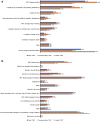A Global Survey of Disease Burden in Patients Who Carry a Diagnosis of Chronic Inflammatory Demyelinating Polyneuropathy
- PMID: 33113101
- PMCID: PMC7854453
- DOI: 10.1007/s12325-020-01540-6
A Global Survey of Disease Burden in Patients Who Carry a Diagnosis of Chronic Inflammatory Demyelinating Polyneuropathy
Erratum in
-
Correction to: A Global Survey of Disease Burden in Patients Who Carry a Diagnosis of Chronic Inflammatory Demyelinating Polyneuropathy.Adv Ther. 2021 Feb;38(2):1364-1367. doi: 10.1007/s12325-020-01586-6. Adv Ther. 2021. PMID: 33439475 Free PMC article. No abstract available.
Abstract
Introduction: The extent to which work productivity, emotional well-being, social interactions, and family life are impacted in patients who self-identify as having chronic inflammatory demyelinating polyneuropathy (CIDP) is not well characterized.
Methods: Data from an online survey of 595 individuals with self-reported CIDP, recruited by the Guillain-Barré syndrome (GBS)/CIDP Foundation, were used to assess disease and treatment burden. A total of 37% of patients were classified as "likely", 34% as "somewhat likely", and 28% as "unlikely" CIDP.
Results: Of ten symptoms that patients with CIDP may experience, each symptom was experienced by 77-94% of "likely", 79-96% of "somewhat likely", and 66-91% of "unlikely" patients. In "likely" CIDP patients 44% stopped working because of their symptoms and 24% moved to a new home. The most common treatments were intravenous immunoglobulin (IVIg) infusion and corticosteroids. IVIg was associated with venous access issues and work/school absenteeism.
Conclusions: CIDP diagnostic confirmation was not performed in any of the survey respondents. Our results do not add any knowledge on the diagnosis or treatment of CIDP. Our findings do provide insight into the symptoms that patients that think they have CIDP or have been told they have CIDP experience, explores how patients that are labeled as having CIDP view treatment expectations, and highlights how these symptoms affect home and work life. We hope that the findings are constructively used to get patients the services they need to improve quality of life, maintain employment, and ensure a safe home environment regardless of diagnostic accuracy.
Keywords: CIDP; Disease burden; Supportive care.
Figures






References
Publication types
MeSH terms
LinkOut - more resources
Full Text Sources
Medical

